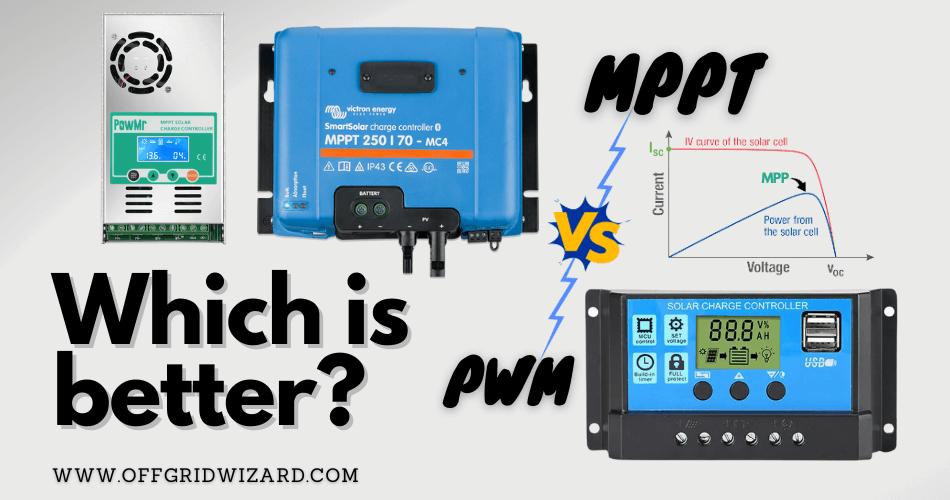Have you ever wondered how solar energy is stored after it’s harvested by solar panels on rooftops? That’s where solar charge controllers come into play. They’re the unsung heroes of solar power systems, diligently managing the power flowing from the panels to the batteries. Without them, we’d risk overcharging batteries, which can be harmful.
Basically, there are two main types of solar charge controllers: MPPT (Maximum Power Point Tracking) and PWM (Pulse Width Modulation). Each has its unique way of ensuring your batteries charge correctly and efficiently. These devices are critical in regulating the transfer of power from solar arrays to battery banks, ensuring maximum efficiency and longevity. Let`s compare and contrast; what are the differences between MPPT and PWM?
Table of Contents
MPPT: The Advanced Energy Optimizer
MPPT (Maximum Power Point Tracking) charge controllers know how to squeeze every bit of power out of your solar panels. As the name suggests, they operate by pinpointing the maximum power point (MPP) on the IV curve of a solar panel.

Through sophisticated algorithms, MPPT controllers continuously track this point, dynamically adjusting the input impedance to match the solar array’s output impedance, thereby extracting maximum available power under all irradiance conditions.
What sets MPPT controllers apart is their ability to convert excess voltage into amperage. This feature is particularly beneficial in sub-optimal light conditions or when panel voltages are significantly higher than battery voltages, as it allows for energy harvesting that would otherwise be lost with less advanced technologies. It’s like getting the most juice out of an orange with a really good juicer.
PWM: The Reliable and Cost-Effective Regulator
In contrast, PWM charge controllers offer a more straightforward approach. They function by essentially connecting the solar array directly to the battery bank, matching the charging voltage to the battery’s state of charge. This results in a direct energy transfer – the ‘pulse’ in Pulse Width Modulation – which is modulated to protect the battery from overcharging by reducing the charge current as the battery reaches its full capacity.
While PWM controllers are less expensive and provide a suitable solution for systems where the solar panel voltage closely matches the battery voltage, they lack the flexibility and efficiency enhancements of MPPT in diverse temperature ranges and with varying voltages.
MPPT vs PWM: A Technical Efficiency Analysis
From a technical standpoint, MPPT controllers exhibit superior performance with efficiencies up to 98%, thanks to their ability to capitalize on the non-linear characteristics of solar panel voltage-current relationships.
This is particularly evident when considering the benefit of MPPT controllers in series-connected PV arrays, which can take advantage of higher string voltages.
Conversely, PWM controllers generally operate at around 75% to 80% efficiency, given that they are more suited for parallel-connected PV arrays with voltage outputs that match the battery system.
MPPT vs PWM, which is better?
When contemplating MPPT vs PWM solar charge controller integration into a photovoltaic system, the decision should be predicated on an analysis of system size, the total cost of ownership, array configuration, and the specific energy demands of the application.
So, is MPPT better than PWM? Yes, for large-scale systems where the costs of PV modules and batteries represent a significant portion of the total system cost, the efficiency gains of MPPT controllers often outweigh their higher initial price point.
For smaller, residential, or recreational applications, a PWM controller might provide an economically sensible solution without sacrificing much in the way of overall system performance.
Real-World Performance Metrics
To quantify the discussion, let’s assume a scenario involving a 100W solar panel with a Vmpp (Voltage at maximum power point) of 18V. Under optimal conditions, an MPPT controller can effectively deliver 5.56A to the battery. It’s like getting the full 100W straight to your battery.
However, if the battery is at 12V, a PWM controller would result in a current closer to 5.56A * (12V/18V) = 3.70A, revealing a clear disparity in charge current delivery. It’s more like getting 70W or 80W out of 100W. That is the Advantage of MMPT over PWM
Conclusion
In essence, while both MPPT and PWM controllers serve the fundamental purpose of regulating solar charging, MPPT controllers offer advanced, adaptive technology that can maximize energy harvest, especially in varied environmental conditions and system configurations. The technical sophistication of MPPT comes at a higher cost but can deliver significant gains in power conversion efficiency. So it is a strategic investment for complex or larger systems.
Conversely, PWM controllers offer a pragmatic, lower-cost option that is effective within its more limited operational scope, making it ideal for uncomplicated, cost-sensitive installations.
Whether you decide to integrate a sophisticated combined inverter with a charge controller or opt for a standalone charge controller, you’re now equipped with the knowledge to select the right solution for your solar energy system.
For those who are ready to take the next step, determining the size of your charge controller is crucial. We’ve got you covered with a comprehensive guide to get you started.
